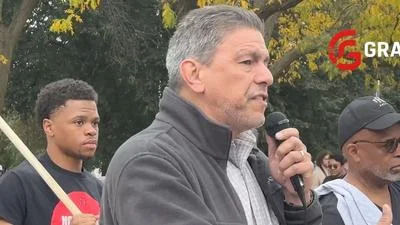City of Wheaton City Council met Feb. 27.
Here are the minutes provided by the council:
I. Call to Order
The Wheaton City Council Planning Session was called to order at 7:20 p.m. by Mayor Suess. The following were:
Physically Present: Mayor Suess
Councilman Barbier
Councilwoman Bray-Parker
Councilwoman Fitch
Councilwoman Robbins
Councilman Weller
Absent: Councilman Brown
City Staff Present: Michael Dzugan, City Manager
John Duguay, Assistant City Manager
James Kozik, Director of Planning & Economic Development
Robert Lehnhardt, Director of Finance
Joseph Tebrugge, Director of Engineering
Erik Berg, Management Analyst
Brandon Kowalke, Senior Management Analyst
Halie Cardinal, Public Relations Coordinator
II. Public Comment
There was no public comments.
III. Approval of Planning Session Minutes – January 23, 2023
The City Council approved the January 23, 2023 City Council Planning Session Minutes.
IV. East Loop Road Corridor Traffic Study
City Manager Michael Dzugan stated that the consultants, Kenig, Lindgren, O’Hara, Aboona, Inc. (KLOA), will present the East Loop Road Corridor Traffic Study. He stated that the East Loop Road Corridor Traffic Study was required as per Ordinance O‐2022‐44, which granted a special use permit for the planned unit development of a WashU carwash in the PUD on the northeast corner of East Loop Road and Butterfield Road.
Director of Engineering Tebrugge stated that the traffic study focused on the East Loop Road corridor generally from Jahns Drive to Butterfield Road. He stated that this study analyzed existing traffic conditions, future 2028 traffic conditions with the car wash, future 2028 traffic conditions with the car wash and a possible additional restaurant development on the north end of the car wash parking lot. He stated that the study also evaluated corridor improvements, and the results of the study illustrate that the corridor is designed well and works as expected for a busy major collector road. He stated that the future 2028 condition shows that the East Loop Road Corridor has adequate reserve capacity to handle the increase in traffic even with all the adjoining properties fully operating. All of the intersections and turning movements continue to work very well with the exception of the left hand turns out of the Chick‐Fil‐A access drive which start to experience an increased delay.
In response to a Council question, Director of Engineering Tebrugge stated that the original study from the corridor’s establishment somewhat differs from this current study since it was conducted with generalized ideas of zoning and had different classifications. Michael Werthmann of KLOA stated that at the time of the original study there were no volumes to evaluate.
Werthmann presented the East Loop Road Corridor Traffic Study for the north-south section of East Loop Road. East Loop Road is an approximate 0.6-mile road that extends in a quarter circle between IL 56 and Naperville Road. The road has a three-lane cross-section and is under traffic signal control at its intersections with IL 56 and Naperville Road. KLOA evaluated the peak hours of the weekday mornings, weekday evenings, and Saturdays. KLOA thoroughly documented the existing roadway conditions, estimated the projected traffic volumes based on the projected growth in the area, evaluated the existing and projected operations, and examined alternative improvements and/or modifications. He stated that KLOA also obtained crash data from 2017 to 2021 for the four intersections in the study area and determined an average crash number of 4.2 per year.
He stated that assuming the 2028 traffic conditions with and without the potential 7,000-square-foot restaurant, the IL 56/East Loop Road intersection and all the critical movements at the stop sign controlled intersections are projected to operate at Level of Service (LOS) D or better. The left-turn movement from the Chick-fil-A access drive is projected to operate at LOS E or F and the East Loop Road southbound approach at IL 56 is projected to operate on the threshold between LOS D/E during certain peak periods.
In response to a Council question, Werthmann stated that acceptable levels of service are defined by grades of A through F, similar to a grading scale for both signalized and unsignalized intersections. The grading scale for both of these types of intersections are similar, but a signalized intersection has a longer delay.
He stated that the results of the gap study conducted along East Loop Road showed that sufficient gaps are available in the East Loop Road traffic stream to accommodate the traffic turning to and from the Chick-fil A access drive and the Rice Lake Square southern access drive. In general, the existing roadway system has sufficient reserve capacity to accommodate the 2028 projected traffic volumes with and without the potential 7,000 square-foot restaurant.
In response to a Council question, Director of Engineering Tebrugge stated that the light at the intersection of East Loop Drive and Butterfield Road already automatically adds seconds as vehicle volume increases to help dissipate traffic.
In response to a Council question, Director of Planning & Economic Development Kozik stated that the north parking lot can be developed with the cooperation of both property owners.
In response to a Council question, Werthmann stated that a restaurant will generate a similar amount of traffic as a car wash on a typical day in the parcel.
In response to a Council question, Director of Engineering Tebrugge stated that the study was conducted with consideration of a 7,000 square-foot restaurant in order to pick a use that was relatively intense to help cover all the other possible uses.
V. Stormwater Utility Fee Assessment
City Manager Dzugan stated that the City has previously discussed the need to review the methodology for funding stormwater operations with current funding at $1.7 million annually. The revenue is received from a rate applied to water consumption.
Management Analyst Berg stated that in 2003 the City established its original stormwater utility fee at a rate of $0.18 per 100 cubic feet of water used. In 2016, the City split the Sewerage Fund into two separate enterprise funds, one for Sanitary Sewers and one for Stormwater Sewer operations. In 2018, the storm sewer rate increased from $0.65 to $0.75 for every 100 cubic feet of water used and the City added a fixed fee of $1.50 per month, which is paid by all properties that use City water. He stated that water usage, which is the basis of the City’s current fee, bears no relationship to the amount of stormwater runoff a property generates. The amount of impervious area on a property strongly correlates to the amount of stormwater runoff it generates.
Management Analyst Berg stated that the most common method of charging stormwater fees is based on impervious area, which involves a standard “billable unit” based on the average amount of impervious area on single-family residential properties, known as an equivalent runoff unit (ERU). An ERU enables the City to charge a proportional fee to each property based on the service demands the property places on the stormwater system.
He presented three fee options:
1. Option 1 Actual ERU – Under this fee structure, every property in the City is billed for the exact amount of impervious area on the property proportional to the City’s ERU of 3,300 square feet.
2. Option 2 – Tiered Residential ERU: Under this fee structure, the City would group single-family properties into tiers based on the amount of impervious area and assign standardized ERU values to those properties.
3. Option 3 – Intensity of Development Factor (IDF): Under this fee structure, the City would calculate the ratio of impervious area to ERU (Actual ERU) and add it to a flat ERU based on the ratio of impervious area (Intensity of Development Factor).
Senior Management Analyst Kowalke stated that adopting a fee based on impervious area better ties the costs of the stormwater utility to the demands individual properties place on the stormwater system.
In response to a Council question, Senior Management Analyst Kowalke stated that Option 1 would call for each individual property to pay the amount of billing units that they have in impervious area. He stated that the value of the ERU remains at 3,300 square feet for all options.
He stated that City staff recommend the City pursue a modified version of the Option 3 – Intensity of Development Factor fee structure. Incorporating the IDF improves upon fee proportionality by factoring in the benefits of impervious areas on property, which help to naturally mitigate stormwater runoff. He stated the next steps for proceeding include determining which operations/costs the stormwater utility fee will cover; determining which fee incentives, credits, and exemptions the City adopts; conducting a full review of property and billing data; communication and stormwater utility fee adoption; and implementation.
In response to a Council question, Senior Management Analyst Kowalke stated City staff plan for further evaluation to handle multi-tenant properties. He stated that during staff research, flood plains have not been a factor of utility fees.
In response to a Council question, City Manager Dzugan stated that the current $1.7 million is taking care of operating the existing system.
In response to a Council question, Senior Management Analyst Kowalke stated that the ERU has the potential to change each year. However, because there are approximately 16,000 residential parcels of which 13,000 are single-family, the ERU would only change based on single-family development. He stated it would take substantial development to change that number.
Council members expressed concerns involving properties within flood zones; potentially substantial increases on property owners’ bills; and shifting the burden from residential owners to commercial/industrial owners since the current mechanism of property taxes works well. The Council expressed interest in implementing this new fee structure to provide relief to residential homeowners.
VI. City Council/Staff Comments
There were no Council/staff comments.
VII. Adjournment
The meeting was adjourned at 8:47 p.m.
https://www.wheaton.il.us/AgendaCenter/ViewFile/Minutes/_02272023-2239





 Alerts Sign-up
Alerts Sign-up